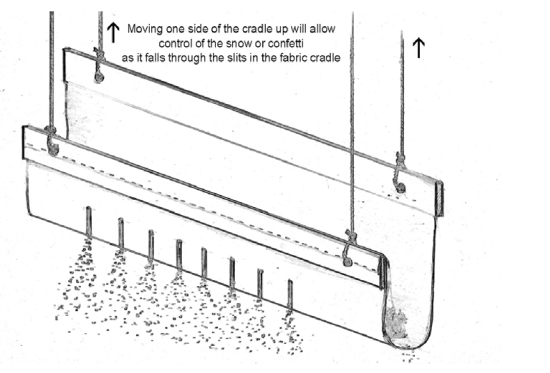7.2: Props and Effects
- Page ID
- 177918
Updated and re-authored by:
In addition to the aforementioned categories of props on chapter 7.1, certain tapes of stage effects are often cataloged and utilized in similar manners as props. In fact, the term “consumable” can also be applied to anything used up or destroyed during a performance such as burning letters or blank ammunition that is fired. Confetti is also considered a consumable.
There’s More to Know Blank-firing weapons are guns that have had their barrel plugged and are not able to be loaded with a live round. These weapons are available in many styles and calibers to match common and period weapons. All replica weapons must be treated with respect and great care. Theatres should have a procedure in place for exactly how the weapon will be used and accounted for. Weapons should be kept under lock and key as much as possible, and only personnel who need to handle the weapon should be allowed to do so. Although a piece of blank ammunition does not have a bullet as a projectile, it is still a controlled explosion occurring in the chamber of the weapon and may propel it’s wadding and other debris at the speed of a bullet. When this explosion occurs, an envelope of hot gas and burning powder flashes out in all directions from the barrel, creating potential danger for anyone in proximity to the weapon. Blank loads are also very loud. The hearing of anyone in proximity to the weapon when fired should be protected.
Weapons are also prop-based special effects that need special care and attention. They are common to many theatre productions, and, although they have always been dangerous items to manage, the current problems facing our society in regards to public shootings have made even handling a plastic replica gun a danger for any public performance. When a blank-firing weapon is used on stage, specific training for the entire company occurs in order to ensure that everyone knows how to stay safe around such an effect. It should also be said that a weapon capable of holding a live round rather than a blank should NEVER be used in a production. Other weapons such as swords, daggers, and even kitchen knives should always have their edges dulled and tips blunted for general safety.
Special effects are associated with props. Often special effects rely on motors and machinery, and so they are also considerations for the set and lighting designer. Common theatre special effects include atmospheric effects such as theatrical fog and haze and practical effects such as snow, rain, and fire.
The responsibilities of special effects are often shared between several production departments. Water effects such as rain, ponds, showers, and sinks often involve the master electrician, both for the installation of associated electrical equipment for pumps, filters, and heaters, but also, from a safety standpoint, their expertise is needed as water and electricity don’t mix well and can add up to significant danger. When needed, a constant pressure flow to practical faucets might be accomplished via a hose to an existing water source or by creating a closed pressurized system by using a garden sprayer.
Weather-based effects have been used in theatre for many years. Thunder, though now usually recreated with a recorded sound effect, was traditionally created using a “thunder sheet,” a large sheet of thin metal that was struck or distorted to produce the sound. Practical rain can be accomplished by a system that is essentially an overhead sprinkler system. However, containing and circulating water is a tricky undertaking and has huge implications for electrical safety.
Fire effects are another area that requires specific expertise to produce a reliable and safe effect. Any live flame likely requires a special permit to be granted by your local fire marshal. Permits for small naked flames, such as those from a candle, match, or cigarette lighter, are reasonably common requests, and depending on your specific production, may be fairly easy to acquire if the proper conditions and procedures are met. LED candles and battery operated torches and fire effects have become quite convincing and are commonly available as practical and safe alternatives to live flame. Audiences today are often very put-off by smoking of any kind onstage. They have become very accepting of miming smoking without ever actually lighting a prop cigarette. Non-nicotine e-cigarettes can also be a convincing alternative.
Unlike rain, snow is a fairly easy effect to achieve onstage with convincing results. A snow cradle is rigged from a batten above the effect area. The cradle is then manipulated to drop a snow-like substance. Depending on your needs, a manufactured snowflake product made from plastic, Styrofoam beads (static causes these to stick to everything), or even dried potato flakes could be used. Snow cradles are also often used to drop flower petals or confetti. Snow machines that produce miniature soap bubbles are also convincing, but the collected soap can be slippery on the stage floor.

Breakaway props like sugar-glass bottles or glassware are common for fight scenes and are commercially available. These props require careful planning with the performers to keep everyone safe. The production needs to order enough of these expendable items for sufficient experimentation and practice. It is possible for an experienced prop artisan to make custom sugar-glass items for a production, but it has become an expensive and time-consuming endeavor.
There’s More to Know Common prop elements such as glassware, silverware, and dishes must be carefully washed after each performance so that germs are not passed among the cast. Items like pipes or cigarette holders should be carefully labeled so they are not shared by multiple performers. All food and beverages should be refrigerated to keep them fresh and safe. In addition, people working on a production are often subject to health issues as they are getting enough rest and are stressed during production periods. Anything you can do to keep everyone healthy is a worthwhile investment.
Breakaway furniture and collapsing crates may be made either from a soft wood such as balsa, or can be pre-broken and held together lightly so actors won’t be injured by their impact. Many extra breakaway objects should be kept on standby and for rehearsals.
Consider This When glassware is required onstage, it is often advisable to use a plastic or acrylic alternative to actual, breakable glass. Unless you are “clinking” glasses, they will be convincing replacements and can prevent what otherwise can be both a safety hazard and a time-consuming cleanup onstage.
Productions using weaponry or breakaway props and furniture also require an expert in stage combat to work with the cast and crew to carefully plan the actions involved so they are convincing for the audience as well as repeatable and safe.
Atmospheric effects, such as fog, smoke, and haze, have become very common to in productions. Theatrical fog can be produced in several ways. Fog machines that vaporize a liquid by heating it are used frequently. These units are safe, reliable, and inexpensive to run. This type of fog can be run through a cooling unit, which allows it to hang or drop toward the floor rather than rise as a vapor. Dry ice (CO2) can be employed to create a cool fog that falls and hugs the stage floor. Liquid nitrogen can also be used to produce a pressurized fog effect that can be useful for magic appearances. Smoke and smoke machines are often used as interchangeable terms with fog, though smoke effects should accurately be categorized as pyrotechnic effects. Haze is used to thicken the stage atmosphere. It allows the lighting instruments’ beams to be seen. The look of a rock concert is achieved through the use of haze. Hazer units are similar to fog machines but continuously put out a light vapor distributed over a large area.

For Further Exploration James, Thurston. 1987. The Theater Props Handbook: A Comprehensive Guide to Theater Properties, Materials, and Construction. White Hall: Betterway Publications. “Instructables - How to Make Anything.” n.d. Instructables.Com. Accessed August 16, 2018. https://www.instructables.com/.



